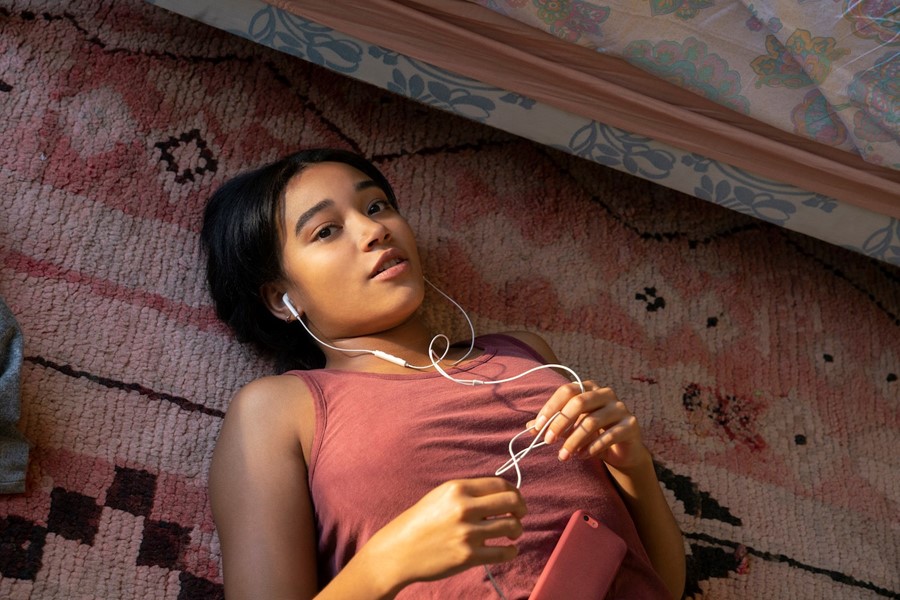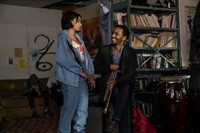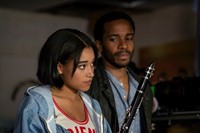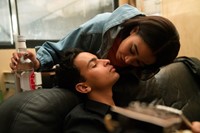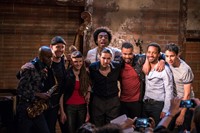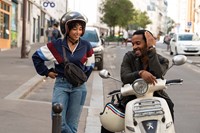La La Land and Whiplash director Damien Chazelle’s new series The Eddy captures life in a jazz club in contemporary Paris. Here, one of its stars, Amandla Stenberg tells us more
This article is published as part of our #CultureIsNotCancelled campaign:
When American actress Amandla Stenberg was approached to star in Damien Chazelle’s new Netflix series The Eddy – a gripping, eight-part drama-slash-musical about a jazz club in contemporary Paris – she was, she says, immediately “smitten” by her character. Julie is a vivacious yet vulnerable 16-year-old who flees the New York home of her mother and creepy stepfather for the French capital to reconnect with her estranged father, Elliot Udo (played by the brilliant André Holland). Udo is a famous American jazz musician, who has been taking refuge in French capital following a family tragedy, busying himself with his struggling jazz club, The Eddy, and the managing of its talented house band. Julie is somewhat of a wild card, determined to test her father’s limits, while silently seeking his affection.
“I thought Julie was very funny,” Stenberg tells AnOther, speaking from her native Los Angeles, where she says she’s been spending lockdown doing yoga, cooking and making TikTok videos. “She’s a lot to handle, but in a way that presented a really fantastic opportunity to try things that I’d never tried before.” There were many things about the experience that were new for the 21-year-old, also a respected activist and accomplished singer – as a number of scenes in The Eddy attest. For Julie, she had to learn to play the clarinet, to speak French, and to adapt to a whole new style of acting and filming, courtesy of Chazelle’s famously experimental style of directing.
To understand the full extent of this it’s helpful to know a bit about The Eddy’s conception. The show took almost a decade to realise: in 2013, the American songwriter Glen Ballard wrote the set of heartfelt songs at the show’s centre and suggested to Alan Poul – its executive producer, and one of its four directors – that a TV series could be built around them. Soon, Chazelle came on board, lured in by the music (he is, as anyone who’s seen his frenetic debut feature Whiplash will know, a devout jazz fan) and the prospect of shooting in Paris, where he spent part of his childhood. As with Whiplash, he was keen to film The Eddy in a way that echoed the tempo and ad hoc nature of jazz itself, while paying tribute to the similarly spontaneous, hyper-realist cinéma vérité movement born in 1960s Paris.
As such, the Paris of The Eddy is a far cry from the heavily romanticised view of the city we’re so used to seeing on screen – a gritty but no less beautiful love letter to what Chazelle terms “the real Paris” and its rich diversity. “During filming, I learned what Paris actually is and what it really looks like, which is very different from how I conceptualised it before,” Stenberg says with audible nostalgia. “It’s a very multicultural place that’s influenced by so many different groups of people, which I came to understand both through my own experiences there, and through the show, which centres on a lot of North African characters.”
Each episode of The Eddy is dedicated to one of the show’s key characters – a troubled but decidedly lovable bunch – and its directors (Chazelle, Poul, Houda Benyamina, and Laïla Marrakchi) took on two consecutive episodes each. This began with Chazelle, who directed Julie’s episode, and set the tone and rhythm of filming, which Stenberg describes as “kinetic and improvisational”. “Damien and Houda Benyamina compiled a list of films that we should watch to get us in the right mindset before we started filming – there was some Godard on there; A Nos Amours by Maurice Pialat; Girlhood; Blue is the Warmest Colour and this film called The Class, that I really loved. It was all French, almost documentarian, raw cinema,” she explains. “I love that style of filmmaking, and I feel like it required me to take myself down a notch; to lean into what was real – especially as it involved a lot of improvising.”
Stenberg is impeccable in her role, encapsulating all the highs and lows of being a mid-teen: the righteous fury, the self-doubt disguised as self-assurance, the frantic bids for freedom, the cringe-worthy, alcohol-fuelled escapades and above all the need to be loved and accepted for who you are, even as you’re still discovering it for yourself. “I understood what it’s like to be in that particular phase of life where you’re projecting really large images of yourself outward into the world while your actual sense of self is fragile,” she explains. “I’m glad that part of my life is done,” she adds with a laugh, “but it was really gratifying to delve into [those memories of] feeling so alone or so misunderstood at moments. I read Girl, Interrupted before shooting and re-read Catcher in the Rye – I threw a little teen angst in there! I wanted to make Julie feel really precocious but also really young, because she is at the end of the day, and that’s why she’s making so many mistakes.”
The naturalism at play in The Eddy, courtesy of its free-wheeling direction and pitch-perfect cast – musically as well as dramatically, all of the emotive jazz performances were filmed live – is its greatest strength. The story line is filled with plenty of thrilling twists and turns – Elliot has found himself unwillingly ensnared in a battle with a Parisian crime lord, who is threatening to destroy everything and everyone he holds dear – but it’s The Eddy’s diverse array of complicated characters, brought together by their unshakeable love of music, that really compels. “I hope that what strikes people about this series is just the commonality of our human experiences,” Stenberg agrees as our conversation draws to a close. “The fact that we’re all on our own journeys, which involve a beautiful range of emotions, and difficulties – life and death – all those grains that form the meat of our experiences here on this earth.”
The Eddy is streaming on Netflix now.
